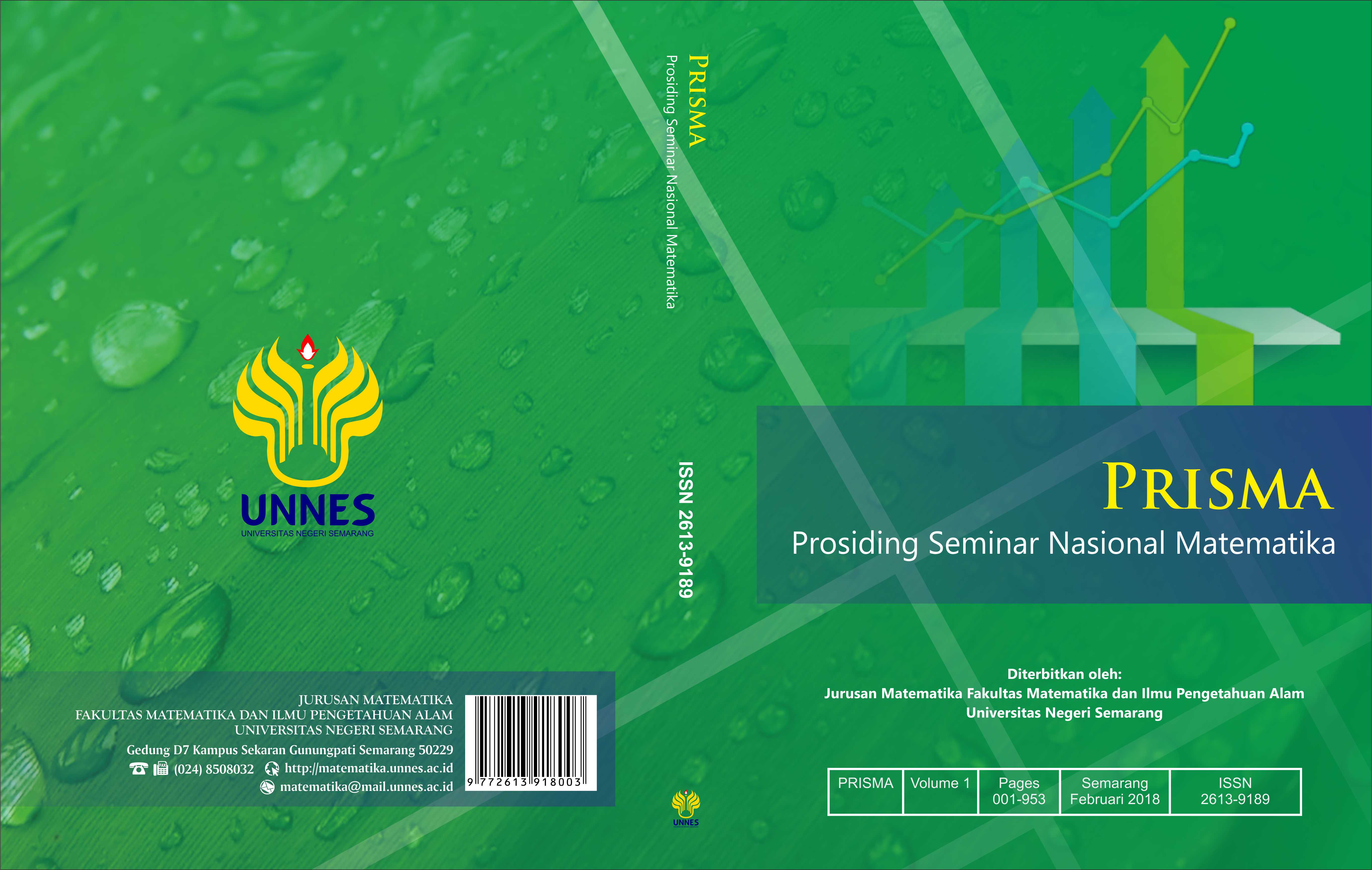KEMAMPUAN BERPIKIR ALJABAR MAHASISWA DALAM MATERI TRIGONOMETRI DITINJAU DARI LATAR BELAKANG SEKOLAH MALALUI PEMBELAJARAN BERBASIS MASALAH
Main Article Content
Abstract
Tujuan penelitian ini adalah mendiskripsikan indikator kemampuan berpikir aljabar dan pemecahan masalah mahasiswa pada trigonometri. Subjek penelitian ini sebanyak 66 mahasiswa semseter dua pendidikan matematika FKIP Universitas Pancasakti Tegal Indonesia yang menempuh matakuliah Trigonometri dari bulan Maret 2017 sampai Mei 2017. Mahasiswa tersebut berasal dari berasal dari SMA IPA, SMA IPS dan SMK dari sekolah negeri dan swasta. Indikator kemampuan berpikir aljabar mahasiswa yang diperiksa adalah (1) Kemampuan pemecahan masalah, (2) Matematika sebagai alat untuk fungsi dan Pemodelan Matematika, (3) Aljabar sebagai Bahasa Matematika, (4) Aljabar sebagai Representasi, (5) Kemampuan Quantitative Reasoning. Indikator pemecahan masalah mahasiswa yang dipelajari (1) Memahami masalah yang meliputi (2) Menyusun rencana pemecahan, atau memilih strategi, (3) Melaksanakan perhitungan atau menyelesaikan model matematis, dan (4) Mmemeriksa kembali hasil yang diperoleh. Hasil yang diperoleh kemampuan berpikir aljabar mahasiswa pada trigonometri untuk kemampuan pemecahan masalah dan kemampuan Quantitative Reasoning cukup kuat. Untuk Kemampuan menggunakan matematika sebagai alat untuk fingsi dan pemodelan matematika, Aljabar sebagai bahasa matematika dan aljabar sebagai representasi masih lemah. Kemampuan berpikir aljabar dan kemampuan pemecahan masalah mahasiswa dari kelompok SMA/MA IPA lebih kuat daripada kelompok SMA/MA IPS dan kelompok SMK
Article Details
References
Arif Lingga dan Winda Sari. 2013. Pengaruh Kemampuan Berpikir Aljabar terhadap Kemampuan Pemecahan Masalah Matematika (studi kasus di kelas VIII sMP negeri 1 kaliwedi kabupaten cirebon) http://www.syekhnurjati.ac.id/jurnal/-index.php/eduma/article/view/45/45.
Carolyn Kieran. 2004. Algebraic thinking in the early grades: What is it (). Available from: The Mathematics Educator 2004, Vol.8, No.1, 139 – 151.
Driscoll, M. (1999). Fostering algebraic thinking: A guide for teachers grades 6–10. Portsmouth, NH: Heinemann Newark, DE (USA).
Farmaki, V., Klaovdatos, N., & Verikios, P. 2005. Introduction to algebraic thinking: Connecting the concepts of linear function and linear equation. Scientia paedagogica experimentalis 42(2), 231-253.
George Bookera, Will Windsor. 2010. Developing Algebraic Thinking: using problem-solving to build from number and geometry in the primary school to the ideas that underpin algebra in high school and beyond. International Conference on Mathematics Education Research 2010 (ICMER 2010).
Heinz Steinbring. 2009. Basic Characteristics of Algebraic Thinking: ›Signs as Descriptors ‹vs.› Signs as Creators‹ A reaction to the Plenary talk by Luis Radford: Signs, Gestures, Meanings: Algebraic Thinking from a Cultural Semiotic Perspective. Proceedings of CERME 6, January 28th-February 1st 2009, Lyon France © INRP 2010
Herbert, K., & Brown, R. H. 1997. Patterns as tools for algebraic reasoning. Teaching Children Mathematics, 3, 340-344.
Herstein, I. N. 1964. Topics in Algebra, "An algebraic system can be described as a set of objects together with some operations for combining them". Ginn and Company.
Cai, J., Lew, H. C., Morris, A., Moyer, J. C., Ng, S. F., & Schmittau, J. 2005. The development of studients' algebraic thinking in earlier grades. Zentralblatt für Didaktik der Mathematik, 37(1), 5-15.
Jones, M. 2011. Exploring algebraic thinking in post − 16 mathematics: The Interpretations of Letters. In Smith, C. (Ed). Proceedings of the British Society for Research into Learning Mathematics. 31(3). UK: BSRLM. 89−94.
Kieran, C. 2004. Algebraic thinking in the early grades: What is it? The Mathematics Educator, 8(1), 139-151.
Kieran, C., & Chalouh, L. 1993. Prealgebra: the transition from arithmetic to algebra. In Douglas T. Owens (Ed.), Research ideas for the classroom: Middle grades mathematics (pp. 178- 192). Reston, VA: National Council of Teachers of Mathematics.
Kriegler, S., Gamelin, T., Goldstein, M., & Chan, H. H. 2007. Introduction to algebra. Los Angeles, CA: Center for.
Kriegler, S. 2007. Just What Is Algebraic Thinking. Introduction to algebra. Centre for Mathematics and Teaching Press. Los Angeles, CA. Retrieved on June 6, 2011 from http://introtoalg.org/downloads/articles-01-kriegler.pdf
Kamol, N. & Har, Y. B. 2011. Upper Primary School Students’ Algebraic Thinking. Fremantle: MERGA.
National Council of Teachers of Mathematics. 2000. Principles and Standards for School Mathematics. Reston, VA: Author
Pedoman Akademik Universitas Pancasakti Tegal 2016.
Pournara, C., Sanders, Y., Adler, J., & Hodgen, J. 2016. Learners' errors in secondary algebra: insights from tracking a cohort from Grade 9 to Grade 11 on a diagnostic algebra test. Pythagoras 37(1), 1-10.
Radford, L. 2006. Algebraic thinking and generalization of Pattern: A semiotic Prespective. Proceedings of Twenty Eighth Annual Meeting of the North American Chapter of the International Group for the Psychologi of Mathematic Education
Sugiyono. 2016. Metode penelitian Kombinasi (Mixed Methode). Bandung: ALFABETA
Windsor. Algebraic Thinking- More to Do with Why, Than X and Y. Lecturer Mathematics Education, Faculty of Education, Griffith University, Mt. Gravatt Campus, Brisbane, Queensland, Australia.
Xin, Y. P., Jitendra, A. K., & Deatline-Buchman, A. 2005. Effects of mathematical word Problem—Solving instruction on middle school students with learning problems. The Journal of Special Education 39(3), 181-192.
